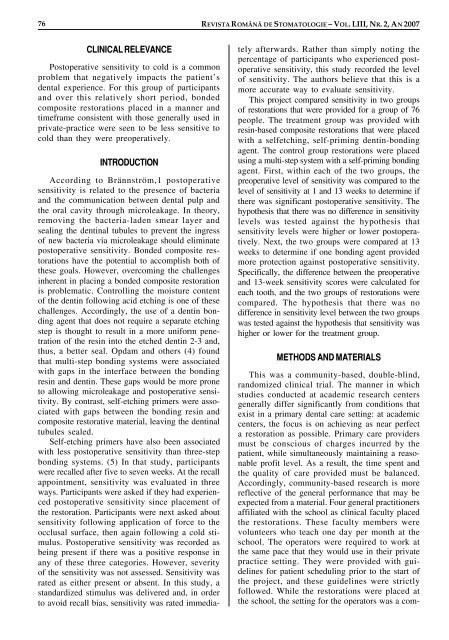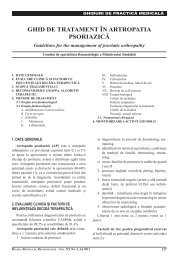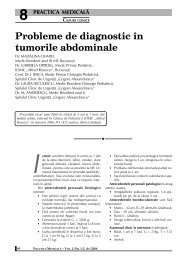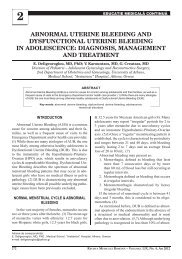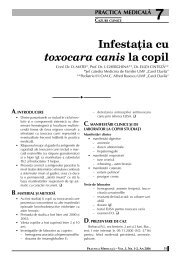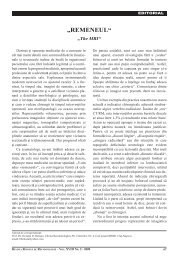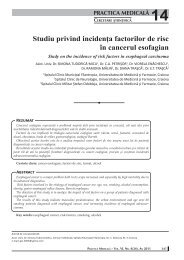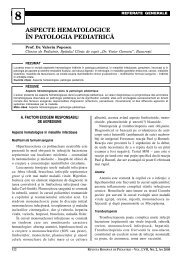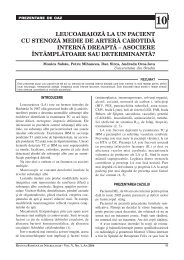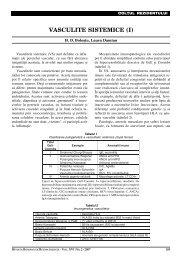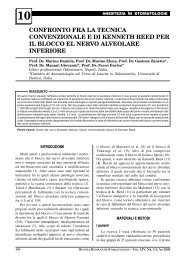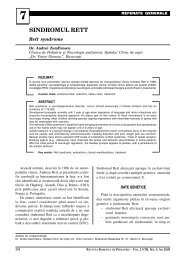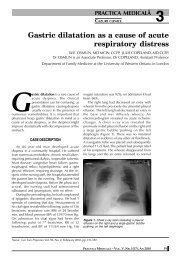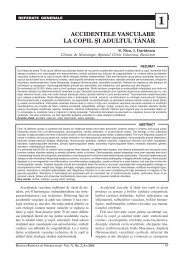Cuprins - medica.ro
Cuprins - medica.ro
Cuprins - medica.ro
You also want an ePaper? Increase the reach of your titles
YUMPU automatically turns print PDFs into web optimized ePapers that Google loves.
76 REVISTA ROMÂNÅ DE STOMATOLOGIE – VOL. LIII, NR. 2, AN 2007<br />
CLINICAL RELEVANCE<br />
Postoperative sensitivity to cold is a common<br />
p<strong>ro</strong>blem that negatively impacts the patient’s<br />
dental experience. For this g<strong>ro</strong>up of participants<br />
and over this relatively short period, bonded<br />
composite restorations placed in a manner and<br />
timeframe consistent with those generally used in<br />
private-practice were seen to be less sensitive to<br />
cold than they were preoperatively.<br />
INTRODUCTION<br />
According to Brännström,1 postoperative<br />
sensitivity is related to the presence of bacteria<br />
and the communication between dental pulp and<br />
the oral cavity th<strong>ro</strong>ugh mic<strong>ro</strong>leakage. In theory,<br />
removing the bacteria-laden smear layer and<br />
sealing the dentinal tubules to prevent the ingress<br />
of new bacteria via mic<strong>ro</strong>leakage should eliminate<br />
postoperative sensitivity. Bonded composite restorations<br />
have the potential to accomplish both of<br />
these goals. However, overcoming the challenges<br />
inherent in placing a bonded composite restoration<br />
is p<strong>ro</strong>blematic. Cont<strong>ro</strong>lling the moisture content<br />
of the dentin following acid etching is one of these<br />
challenges. Accordingly, the use of a dentin bonding<br />
agent that does not require a separate etching<br />
step is thought to result in a more uniform penetration<br />
of the resin into the etched dentin 2-3 and,<br />
thus, a better seal. Opdam and others (4) found<br />
that multi-step bonding systems were associated<br />
with gaps in the interface between the bonding<br />
resin and dentin. These gaps would be more p<strong>ro</strong>ne<br />
to allowing mic<strong>ro</strong>leakage and postoperative sensitivity.<br />
By contrast, self-etching primers were associated<br />
with gaps between the bonding resin and<br />
composite restorative material, leaving the dentinal<br />
tubules sealed.<br />
Self-etching primers have also been associated<br />
with less postoperative sensitivity than three-step<br />
bonding systems. (5) In that study, participants<br />
were recalled after five to seven weeks. At the recall<br />
appointment, sensitivity was evaluated in three<br />
ways. Participants were asked if they had experienced<br />
postoperative sensitivity since placement of<br />
the restoration. Participants were next asked about<br />
sensitivity following application of force to the<br />
occlusal surface, then again following a cold stimulus.<br />
Postoperative sensitivity was recorded as<br />
being present if there was a positive response in<br />
any of these three categories. However, severity<br />
of the sensitivity was not assessed. Sensitivity was<br />
rated as either present or absent. In this study, a<br />
standardized stimulus was delivered and, in order<br />
to avoid recall bias, sensitivity was rated immedia-<br />
tely afterwards. Rather than simply noting the<br />
percentage of participants who experienced postoperative<br />
sensitivity, this study recorded the level<br />
of sensitivity. The authors believe that this is a<br />
more accurate way to evaluate sensitivity.<br />
This p<strong>ro</strong>ject compared sensitivity in two g<strong>ro</strong>ups<br />
of restorations that were p<strong>ro</strong>vided for a g<strong>ro</strong>up of 76<br />
people. The treatment g<strong>ro</strong>up was p<strong>ro</strong>vided with<br />
resin-based composite restorations that were placed<br />
with a selfetching, self-priming dentin-bonding<br />
agent. The cont<strong>ro</strong>l g<strong>ro</strong>up restorations were placed<br />
using a multi-step system with a self-priming bonding<br />
agent. First, within each of the two g<strong>ro</strong>ups, the<br />
preoperative level of sensitivity was compared to the<br />
level of sensitivity at 1 and 13 weeks to determine if<br />
there was significant postoperative sensitivity. The<br />
hypothesis that there was no difference in sensitivity<br />
levels was tested against the hypothesis that<br />
sensitivity levels were higher or lower postoperatively.<br />
Next, the two g<strong>ro</strong>ups were compared at 13<br />
weeks to determine if one bonding agent p<strong>ro</strong>vided<br />
more p<strong>ro</strong>tection against postoperative sensitivity.<br />
Specifically, the difference between the preoperative<br />
and 13-week sensitivity scores were calculated for<br />
each tooth, and the two g<strong>ro</strong>ups of restorations were<br />
compared. The hypothesis that there was no<br />
difference in sensitivity level between the two g<strong>ro</strong>ups<br />
was tested against the hypothesis that sensitivity was<br />
higher or lower for the treatment g<strong>ro</strong>up.<br />
METHODS AND MATERIALS<br />
This was a community-based, double-blind,<br />
randomized clinical trial. The manner in which<br />
studies conducted at academic research centers<br />
generally differ significantly f<strong>ro</strong>m conditions that<br />
exist in a primary dental care setting: at academic<br />
centers, the focus is on achieving as near perfect<br />
a restoration as possible. Primary care p<strong>ro</strong>viders<br />
must be conscious of charges incurred by the<br />
patient, while simultaneously maintaining a reasonable<br />
p<strong>ro</strong>fit level. As a result, the time spent and<br />
the quality of care p<strong>ro</strong>vided must be balanced.<br />
Accordingly, community-based research is more<br />
reflective of the general performance that may be<br />
expected f<strong>ro</strong>m a material. Four general practitioners<br />
affiliated with the school as clinical faculty placed<br />
the restorations. These faculty members were<br />
volunteers who teach one day per month at the<br />
school. The operators were required to work at<br />
the same pace that they would use in their private<br />
practice setting. They were p<strong>ro</strong>vided with guidelines<br />
for patient scheduling prior to the start of<br />
the p<strong>ro</strong>ject, and these guidelines were strictly<br />
followed. While the restorations were placed at<br />
the school, the setting for the operators was a com-


